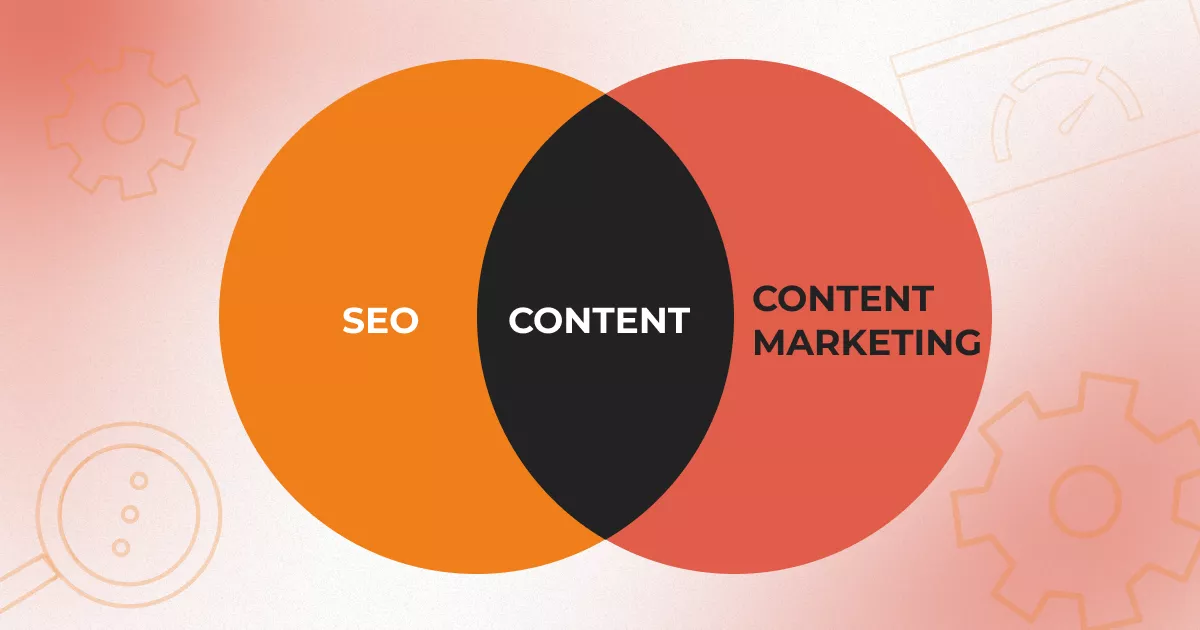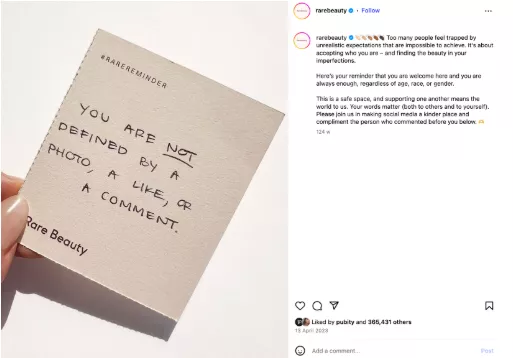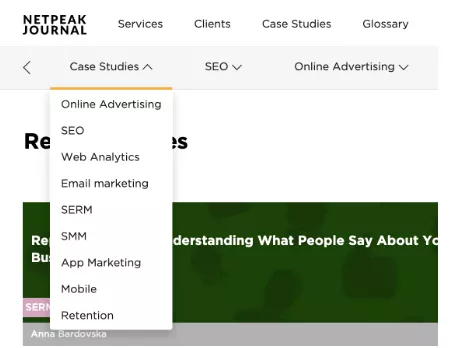Why have marketers even started contrasting content marketing with SEO? It’s like trying to decide which leg is more important for running a marathon, the left or the right. To reach the finish line, they must cooperate.
Let's use another comparison, because I really want to. Content is like Taylor Swift’s hit songs — they engage people and draw them in. SEO is the manager who fills the stadium — without it, she would be performing to empty seats. You need both to make a show.
In this guide, I'll show how befriending content marketing and SEO can affect your visibility & bottom line.
Investing in SEO and content marketing isn’t just about appearing in Google search results; it’s about creating long-term business value. SEO ensures that your brand is discoverable when people are searching for what you offer, while content marketing provides a reason for them to trust, remember and choose you.
Writing the Hits: What Content Marketing Is For?
Why does a company need content at all? Because it generates money, first and foremost. According to HubSpot, companies that publish blog content consistently generate 67% more leads than those that don’t.
All blogs, guides, social media posts, emails, videos, podcasts, and so on need to work together to generate income. However, it's not enough to simply write grammatically correct text — it needs to resonate with the reader. It needs to evoke emotion.
For example, Selena Gomez, founder of Rare Beauty, doesn’t just talk about makeup — she uses her platform to shine a light on mental health. She shares her own stories and invites specialists to help people. The audience feels cared for. That’s why Rare Beauty stands out from soulless makeup corporations.
Filling the Stadium: How SEO Brings the Crowd
People use Google to search for information, and then visit the websites that appear on the first pages of results. To reach a high position in the ratings, your business needs SEO services.
It’s about visibility: the ability to offer your product or service to buyers when they may not even be considering making a purchase. This is how you create brand recognition and capture the interest of potential customers or users.
What is the main advantage of SEO? It’s free and powerful. According to SEOinc, organic search drives 53% of all web traffic.
While you don't need to pay Google, you do need to gain their trust (it’s a complicated part). To reach high positions in ratings, your website needs proper keywords, meta titles, descriptions, backlinks, etc. Then people will see your website as the go-to place for solutions to their problems.
If you would like to find out how Netpeak's specialists help to improve website rankings, read our case study about ME-QR, a company that generates QR codes. As a result, priority pages where users convert increased by 320% in clicks.
Hits vs Hype: Key Differences Between Content Marketing and SEO
Sure, it's different processes. While content creators write their Instagram posts, drinking coconut milk filter coffee at a third-wave coffee shop, SEO specialists nervously pour themselves Earl Grey without sugar while trying to put together a website structure that doesn't make sense :)
Content marketing is the “what” (the stories, blogs, videos, guides). SEO is the “how” (keyword research, on-page SEO, information architecture).
Take a peek at this table:
|
Content Marketing |
SEO |
|
|
Core Function |
Storytelling & engagement. Creating informational content that builds trust and brand loyalty. |
Optimization & discoverability. Making sure content has visibility in search results and drives traffic. |
|
Main Tools |
Blogs, videos, podcasts, whitepapers, guides, social posts. |
Keyword research, on-page SEO, technical SEO, and backlinks. |
|
Business Impact |
Long-term relationship building, customer retention. |
Lower acquisition cost, online visibility, and increased conversions. |
|
Risk if Ignored |
You produce content nobody cares about. |
You rank on page 10 and might as well not exist. |
Common Ground
Content marketing and SEO are actually two sides of the same coin. All this work is gaining the same goal — more clients, more revenue.
Here’s what they have in common at their core:
-
At the heart of both is empathy. Successful content marketing tells stories people actually want to read. SEO is about figuring out what they’re frantically Googling at 11 p.m. when they should be sleeping.
-
Neither works without a roadmap. From building keyword lists and topic clusters to planning editorial calendars, both disciplines align content creation with business objectives.
-
Data is where the magic happens. SEO measures rankings, crawlability, and CTR. Content tracks engagement, shares, and conversions. Combined, they give you a 360° view of how to convert your audience into loyal customers.
-
Nothing in digital marketing is static. Algorithms shift, audiences evolve, and competitors catch up. That’s why constant refinement is so important for SEO content: updating posts, sharpening keyword strategies, fixing UX issues to improve user experience, and making sure your content doesn’t age like milk.
Who Will Win?
I love a good debate, with people discussing arguments and slapping their hands on the table. In this case, however, there will be two winners. Boring.
SEO is too technical to touch the hearts of customers — for that, you need storytelling. Even the best content will have no impact if it isn't consumed. These fighters won't even step into the ring against each other because they'll be too busy discussing how AI will soon take their jobs. Just kidding!
A good content marketing strategy and customer engagement will always require a human touch. But you need to combine content and SEO efforts for better results.
Why Content and SEO Should Team Up
Because they are inseparable, like high school sweethearts. Together, they can achieve high results in their studies much more easily, because content can copy maths from SEO, and SEO can copy literature from content.
But putting my completely unbelievable comparisons aside, one truth remains: combining SEO and content helps solve business problems. I'll now show you how.
|
The Challenge |
PlanKey |
Performance Indicators |
Projected Schedule |
|
Flat conversions despite high ad spend |
Align content marketing with SEO and produce valuable, optimized content |
Lead generation, CTR, and conversion rate |
3-6 months for measurable impact |
|
Online visibility suffers; search rankings are poor |
Technical SEO audits, on-page optimization, keyword research, and structured content clusters |
Organic traffic, keyword rankings, indexed pages, backlinks |
1-3 months for initial results |
|
Content and SEO teams don't work together |
Implement a framework with clear roles (SEO specialist, content strategist, project manager) |
Engagement rate, content performance metrics, and internal efficiency |
Set up in 2-4 weeks |
|
Low audience engagement/brand loyalty |
Storytelling-driven content; multi-channel distribution and repurposing |
Time on page, scroll depth, social shares, repeat visits, LTV:CAC |
1-2 months to see engagement trends; sustained growth over 6-12 months |
|
Content not converting despite traffic |
Optimize internal linking, UX, and conversion points; repurpose high-performing types of SEO content |
Sales increase, conversion rate, and lead generation |
1-3 months after optimization; ongoing iterative improvement |
If you would like confirmation of what I told you earlier in the real world, read our case study about the alcohol brand BAYADERA. They had an issue with their website's visibility. A Netpeak specialists helped them achieve 195% growth in organic traffic and 187% growth in revenue.
How to Align SEO and Content Marketing
Aligning these two is less about tactics and more about mindset. Key principles for their marriage:
-
Plan campaigns, topics, and keywords around business goals. This ensures every piece of content has a purpose.
-
Writers, SEO specialists, and marketing strategists should collaborate from day one.
-
Insights from one area (like top-performing content) should inform the other (SEO optimization), creating a continuous loop of improvement.
Content Marketing KPIs vs SEO KPIs
Content marketing and SEO play in the same field, but track different stats.
Content marketing KPIs are more human-centric metrics. Are visitors actually reading your content? At what point do they leave? Do they come back? Do they click?
What you need to track:
-
Lead Generation
-
Time on Page and Scroll Depth
-
Customer Retention Metrics
-
Engagement Rate
SEO KPIs are more search engine-centric metrics. How many visitors arrive via search engines? Can your target audience find your website? Do we like your snippet in search results? Are cool sites linking to your content?
What you need to track:
-
Organic Traffic
-
Keyword Rankings
-
Click-Through Rate (CTR)
-
Backlinks
Content Marketing + SEO Strategy: Baby Steps
Planning your website content and SEO side by side requires some strategic work.
Step 1: Hunt for Audience Insights
Your customers use your products for a variety of purposes. You can’t even imagine! Over 15% of Google searches each day are brand new, so your audience is constantly finding fresh ways to solve their problems. You need to know their ways.
-
Use keyword research to reveal customers' different intentions. Are customers ready to buy (e.g., “best CRM pricing”), looking to learn about your product (e.g., “what is a CRM”), or comparing options (e.g, “HubSpot vs. Salesforce”)?
-
Keywords show the “what,” but only empathy reveals the “why.” “How to fix a sink myself” is about Sunday DIY, but “plumber near me ASAP” is about water flooding the kitchen.
-
Ahrefs and Google Search Console can highlight patterns: trending questions, unclaimed keyword gaps, and topics competitors left on the table.
Step 2: Build the Architecture
Your website’s information architecture is the skeleton of your content strategy.
A clean structure with logical categories improves the user experience (UX), which means a great deal to customers. According to Nielsen Norman Group, users leave a site in 10-20 seconds if they don’t find what they need. You need to show them a way.
Create a clear hierarchy by grouping related content around pillar pages. For example, if you have a core “Beginner's Guide”, include the links to in-depth blogs, FAQs, and case studies. MetricsRule states that using internal links can increase page views by up to 70%.
Last but not least — ChatGPT-style search engines are starting to answer queries directly. That means that you need to structure and optimise content for generative engines that will appear. Whether we like it or not, GEO is the future.
Step 3: Go Omnichannel
Show content where your audience already hangs out — inboxes, feeds, communities, and partner networks.
-
Email: Done well, email is a powerhouse. According to MailModo, email generates $42 for every $1 spent — ROI you can’t ignore.
-
Repurposing: Think of your successful content as a cow: milk it. A 2,000-word guide can become a webinar, TikTok snippets, sales slides, and a podcast episode at the same time.
Step 4: Create the Feedback Loop
SEO and content should create a closed loop of learning:
SEO Data → Content → Performance Data → SEO
-
Keyword rankings show you what your audience actually cares about. For example, if searches for “AI productivity tools” start to increase, you should create content about that topic before your competitors do.
-
Metrics like CTR, bounce rate, and conversions show if your content connects with humans. If a blog post ranks #3 but has a 90% bounce rate, it’s obviously not working.
-
If some content outperforms others (for example, if a case study drives three times more backlinks than a standard blog), create more content in that format.
FAQ
Which is more important: SEO or content marketing?
They are both equally important. Although they use different tools, they work towards the same goal.
Does SEO include content creation?
Content creation becomes part of SEO when you produce optimized blog posts, landing pages, case studies, videos, and other assets for search engines.
Can I succeed with only SEO or only content marketing?
It’s possible in the short term, but combining them creates sustainable growth. SEO without content is empty, and content without SEO is invisible.
How to combine SEO and content marketing?
By treating them as one strategy, not two. SEO gets your content seen, content marketing gets it remembered.
How long does it take to see results from SEO and content marketing?
Typically, 3-6 months for noticeable improvements. Results depend on your industry, competition, and consistency.
Related Articles
Segments vs. Audiences in Google Analytics 4: A Comprehensive Setup Guide
You will learn how to correctly set up custom audiences, allowing you to save time and gain insight into your audience
PPC for E-commerce: How to Buy Attention Without Going Broke
Learn how PPC for e-commerce can drive fast sales for your store without draining your budget. Smart strategies, beginner tips, and proven ways to scale profitably.
Personalization 2.0: Breaking the Deadlock of Cold Newsletters
Most leads in managerial positions receive dozens of similar messages every day. Below, I will present the algorithms and techniques that increased our partners' campaign conversion rates from 1% to 11%






